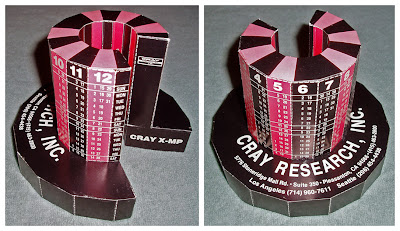Cray computers
I think I owe Rebecca, whose dream computer is the Cray 1, a photo of its first descendant:
Even built it myself! Of course it actually is just a cardboard model of a Cray X-MP that was also a calendar.
When I saw one of those on a desk, I just had to track down the source and make one myself.
Like Rebecca, I loved Cray's computers. His CDC6500 design was my second computer, and I knew it inside and out. Its RISC design made it easy to program, since I could easily keep the state of the machine in my head. Wrote some cool stuff for it, including a macro package that turned the assembler into a FORTRAN in-line compiler and a multi-tasking operating system that beat M$'s (much later) original DOS by a mile. Although the 6500 was wildly out of date by then, I count it as my first supercomputer.
My first computer was some Honeywell model that the school system let my physics teacher use in the off hours. I slammed some code to do a trivial numerical integral (using a Riemann sum) of the potential energy of a beaded chain. It was really doing a calculator sum, but calculators did not exist until a few years later. Used it to show that the potential energy of a free-hanging curve (a catenary) was less than that of other (distorted) shapes held in place by pins. Looking back, that was so cool for its time that it probably would have won some science fairs if I had bothered to enter it. Little does Mr. P know where that experience took me.
Over the years, I used a CDC7600, a Cray 1 (which was sort of the evolved 8600, sort of not), an X-MP, and a Cray 2 (which was sort of the 9600, the plausible reason I give for HAL being in the 9000 series). The immersion in liquid coolant made the Cray 2 rather unique and particularly photogenic. The ETA-10 (the successor to the CDC Star, the ultimate CISC architecture) was immersed in liquid Nitrogen for cooling, which was extremely cool (literally) but could not be seen.
Rebecca, if you want to design an emulator for the Cray 1, I found a copy of the Hardware Reference Manual on the web. Page 3-25 shows the hack he did on the multiply unit to save money at the cost of some minor computational flaws, some of which are documented at that point in the manual.
Seymour Cray was a genius. We lost a lot when he was killed in an accident on a freeway when his Jeep Grand Cherokee overturned.

1 comment:
That is so awesome! Thanks for sharing the Cray memories. :)
Post a Comment